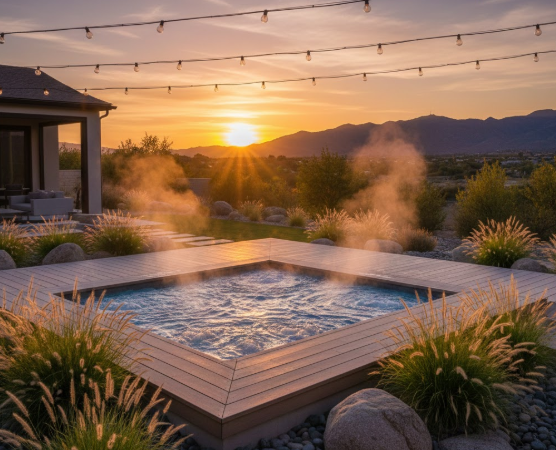Table of Contents - Hot Tub Buying Guide: The Complete Roadmap for US Buyers in 2025
- Making a Smart Investment in Home Hydrotherapy
- Determine Your Needs and Site Requirements
- Hot Tub Classes and Price Tiers Explained
- Core Construction: Shell, Cabinet, and Framing
- Insulation Systems and Energy Efficiency
- The Mechanics: Pumps, Jets, and Heaters
- Water Care and Filtration Systems
- Electrical Requirements and Installation Logistics
- Vetting the Retailer and Understanding Warranties
- Total Cost of Ownership Breakdown
- Smart Shopping Tips and Negotiating
- Conclusion: Final Checklist Before You Sign
- Frequently Asked Questions
- What is the average lifespan of a hot tub?
- How much does it cost to run a hot tub per month?
- Is a salt water hot tub better than chlorine?
- Can I put a hot tub on a deck?
- Do I need a permit to install a hot tub?
- What is the difference between 110V and 220V hot tubs?
- How often should I change the hot tub water?
- What are the health benefits of owning a hot tub?
- Can I use a hot tub in the winter?
- What is the best hot tub brand for cold climates?
This blog post may contain affiliate links. As an Amazon Associate I earn from qualifying purchases.
Hot Tub Buying Guide: What to Know Before You Spend Big
Making a Smart Investment in Home Hydrotherapy
Purchasing a hot tub represents one of the most significant backyard investments you’ll make for your home. This comprehensive hot tub buying guide walks you through every critical decision point, from understanding construction quality to calculating true ownership costs, ensuring you select a spa that delivers years of reliable hydrotherapy.
The hot tub market has evolved dramatically over the past decade. What was once a luxury reserved for high-end homes has become accessible across multiple price points, with options ranging from budget-friendly inflatable models to sophisticated swim spas with advanced automation. This democratization, however, has also created a maze of choices, marketing claims, and confusing specifications that can overwhelm even the most research-savvy buyer.
Whether you’re seeking relief from chronic back pain, a social gathering space for family and friends, or simply a peaceful retreat after long workdays, this guide provides the expert knowledge you need to navigate the market confidently. We’ll cut through manufacturer jargon, expose common sales tactics, and give you the insider perspective that typically takes years of industry experience to develop.
Why a Hot Tub is More Than Just a Backyard Accessory
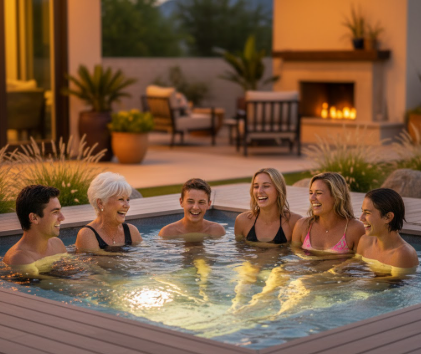
Hot tubs deliver measurable therapeutic benefits backed by medical research. The Arthritis Foundation recognizes warm water therapy as an effective treatment for joint pain and stiffness. Studies published in the New England Journal of Medicine have documented improvements in blood sugar control for Type 2 diabetes patients using hot tub therapy. Beyond clinical applications, regular hot tub use promotes better sleep quality, reduces muscle tension, and provides low-impact exercise opportunities.
The social dimension shouldn’t be underestimated either. Unlike many home additions that see diminishing use over time, hot tubs often become gathering points where families reconnect and friendships deepen. The deliberate act of unplugging from devices and sharing conversation in warm, bubbling water creates opportunities for connection that our increasingly digital lives often lack.
From a property value perspective, well-maintained hot tubs can enhance home appeal during resale, particularly in regions where outdoor living is prized. However, the primary return on investment comes through daily quality-of-life improvements rather than monetary appreciation.
Navigating the Market: From Inflatables to Luxury Spas
Today’s hot tub market segments into distinct categories that serve different needs and budgets. Entry-level inflatable and rotomolded spas start around four hundred to two thousand dollars, mid-range acrylic spas typically fall between four thousand and ten thousand dollars, and premium luxury spas can exceed twenty thousand dollars. Swim spas, which combine hot tub features with swimming capabilities, occupy their own category with prices ranging from fifteen thousand to over fifty thousand dollars.
Understanding where each category excels and where it compromises helps you allocate your budget effectively. An expensive spa isn’t automatically superior for your specific situation, just as a budget model isn’t necessarily a poor choice if your expectations align with its capabilities.
How to Use This Guide to Avoid Buyer’s Remorse
We’ve organized this guide to mirror the actual decision-making process experienced buyers follow. You’ll start by assessing your space and needs, then understand the different hot tub types and price tiers available. From there, we dive deep into construction quality, mechanical systems, and water care technology before covering installation logistics, dealer evaluation, and total ownership costs.
Read this guide completely before visiting dealerships. Sales environments are designed to create urgency and emotional purchasing decisions. Armed with the knowledge contained here, you’ll recognize quality indicators, ask informed questions, and resist pressure tactics that might lead to regret.
Determine Your Needs and Site Requirements
Before browsing models or visiting showrooms, establish clear parameters for your hot tub purchase. Understanding your space constraints, intended use patterns, and installation logistics prevents costly surprises and ensures you select a spa that fits your lifestyle.
Assessing Your Space and Backyard Layout

Your available space directly influences which hot tub models you can consider. Measure your intended location carefully, accounting not only for the spa’s footprint but also for essential clearances around it.
Most jurisdictions require hot tubs to be set back at least five feet from property lines, though local codes vary significantly. Beyond legal requirements, practical considerations matter. You’ll need access space for removing the cover, room to enter and exit safely, and clearance for future equipment service. Plan for at least eighteen inches of clearance on the equipment side for pump and heater access, and three feet minimum around other sides for comfortable use.
Consider privacy when selecting your location. You’ll likely use your hot tub in the evening when neighbors may be in their yards or looking out windows. Strategic placement near fences, walls, or landscape features can create a more intimate atmosphere. Conversely, if you’re installing in a visible location, factor in aesthetic considerations and potentially budget for decorative screening.
Sun exposure affects both comfort and operating costs. A spa positioned in full southern exposure will require more frequent chemical attention due to UV degradation of sanitizers, but may cost slightly less to heat in cooler months. Partial shade often provides the best balance. Avoid placement directly beneath deciduous trees, as falling leaves create ongoing maintenance headaches.
Indoor vs. Outdoor Installation Considerations

Indoor hot tub installations present unique challenges that outdoor placements avoid. Humidity management becomes critical, requiring specialized ventilation systems to prevent moisture damage to walls, ceilings, and structural elements. Expect to budget for commercial-grade exhaust systems capable of multiple air exchanges per hour.
Flooring must withstand constant moisture exposure and potential chemical contact. Sealed concrete, tile over waterproof membranes, or specialized spa flooring are necessary. Standard hardwood or carpet will fail quickly in a hot tub environment.
Drainage requirements are more complex indoors. You’ll need floor drains capable of handling both routine water changes and potential equipment failures. Without proper drainage, a single pump seal failure could cause thousands of dollars in water damage.
That said, indoor installations offer year-round comfort regardless of weather, enhanced privacy, and protection of your spa from UV degradation and environmental exposure. In extreme northern climates, indoor placement can significantly reduce operating costs and extend equipment lifespan.
Measuring for Delivery Access and Final Placement
Hot tub delivery logistics trip up many first-time buyers. Standard seven-to-eight-person spas measure approximately seven by seven feet and weigh between seven hundred and one thousand pounds empty. Getting that bulk from the delivery truck to your backyard requires careful planning.
Measure all gates, walkways, and passages between the delivery point and installation site. Account for not just the spa’s footprint but also the maneuvering room needed to navigate turns. A spa that’s seven feet wide typically needs passages at least forty-four inches wide for straight approaches, but corners require more space.
Standard delivery usually means curbside only. Moving the spa to your backyard may involve additional fees or require you to arrange separate labor. Many dealerships offer “white glove” placement services that include positioning the spa exactly where you want it, connecting it to power, filling it, and performing initial startup. This service typically costs three hundred to eight hundred dollars but eliminates significant headaches.
For challenging access situations, crane services may be necessary. Craning a hot tub over a house or fence typically costs one thousand to two thousand dollars depending on your region and the complexity of the lift. While this adds significant expense, it’s sometimes the only option for enclosed courtyards or rooftop installations.
Understanding Structural Support and Foundation Needs
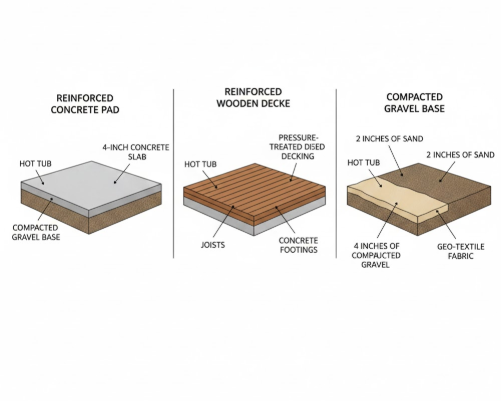
Hot tubs filled with water and occupants can weigh over five thousand pounds. This weight concentrated on a relatively small footprint creates substantial load requirements that not every surface can handle.
Concrete pads offer the most reliable support. A four-inch reinforced concrete pad poured on properly compacted base material provides decades of stable support. For spa-specific applications, the pad should extend at least six inches beyond the spa’s perimeter on all sides. Expect to pay eight hundred to fifteen hundred dollars for professional concrete work, depending on accessibility and regional labor costs.
Existing concrete patios may work if they’re in good condition. Look for cracks, settling, or evidence of poor drainage that could indicate underlying problems. When in doubt, consult with a structural engineer before placing a multi-thousand-pound spa on an existing slab.
Deck installations require careful engineering consideration. Standard residential decks built to code support forty pounds per square foot live load. A filled hot tub with occupants can exert one hundred twenty pounds per square foot or more. Reinforcement is almost always necessary, typically involving additional joists, larger beams, and supplementary post supports. Have a structural engineer or experienced deck builder evaluate your specific situation before proceeding.
Gravel pads offer a budget-friendly alternative for ground-level installations. Four inches of compacted three-quarter-inch crushed stone over landscaping fabric provides adequate drainage and reasonable stability. However, gravel can shift over time and may require periodic releveling. This approach works best for lighter portable spas rather than heavy acrylic models.
Deciding on Seating Capacity and User Ergonomics
Manufacturer seat counts often represent marketing optimism rather than comfortable reality. A “six-person” spa might technically fit six average adults, but comfortable use with adequate personal space may be limited to four.
Consider your actual use patterns rather than occasional maximum occupancy. If you primarily use the spa as a couple, a compact four-person model provides ample room while reducing purchase price, operating costs, and required installation space. The resources at ONE HOT TUB can help you compare different capacity options to match your specific needs.
For those with limited space or more intimate soaking preferences, smaller models offer surprising versatility. A quality 3 Person Hot Tub delivers full hydrotherapy benefits in a compact footprint, making it ideal for smaller patios, urban backyards, or couples who prioritize quality over quantity.
Seat depth and configuration significantly impact comfort across different body types. Taller users need deeper seats to submerge shoulders properly, while shorter users may find very deep seats uncomfortable or even unsafe. This is why the wet test, where you actually sit in a filled spa before purchasing, is absolutely essential.
Lounge Seats vs. Open Seating Arrangements
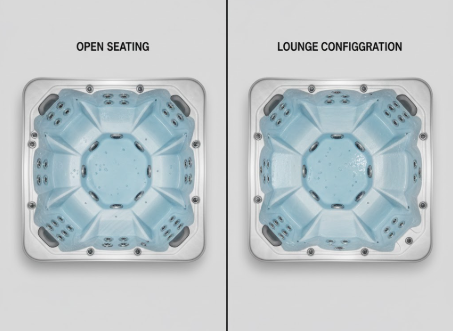
Lounge seats allow one bather to recline with jets targeting the full length of the back and legs. This position provides excellent therapeutic coverage and deep relaxation. However, lounge seats consume substantial interior space, reducing the number of standard seats and limiting flexibility for social soaking.
Open seating arrangements maximize capacity and social interaction. Everyone faces the center, facilitating conversation and allowing occupants to move between different jet configurations easily. This layout also provides more flexibility for users of different sizes since seat depths can vary throughout the spa.
Some spas offer compromise layouts with a partial lounger that doesn’t extend the full length of the spa. These provide some reclining capability while maintaining reasonable capacity. Evaluate your priorities carefully. If hydrotherapy for back and leg muscles is your primary goal, a full lounge makes sense. If family gatherings and entertainment drive your purchase, open seating likely serves you better.
Hot Tub Classes and Price Tiers Explained
Understanding market segmentation helps you calibrate expectations and identify the sweet spot where your budget meets your requirements. Each price tier involves distinct trade-offs in materials, features, and longevity.
Entry-Level Hot Tubs and Inflatables
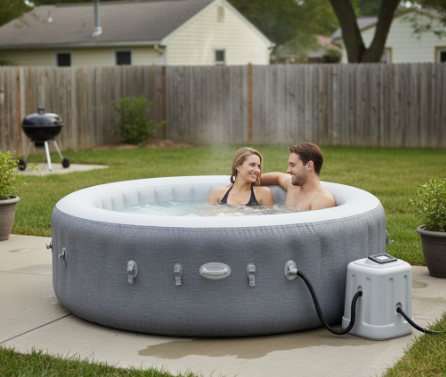
Entry-level spas serve as an accessible introduction to hot water therapy. This category includes inflatable spas, soft-sided models, and basic rotomolded plastic tubs. If you’re exploring options at this end of the market, our guide to Cheap Hot Tubs provides detailed comparisons to help maximize value within budget constraints.
Pros and Cons of Soft-Sided and Rotomolded Spas
Inflatable hot tubs from brands like Intex, Bestway, and Coleman typically cost between four hundred and twelve hundred dollars. They’re genuinely portable, set up in under an hour, and store compactly when not in use. For renters, seasonal users, or those uncertain about long-term commitment to hot tub ownership, inflatables make sense as a trial experience.
However, limitations are significant. Inflatable walls provide minimal insulation, leading to high operating costs in cool weather. Air jets create bubbles rather than the targeted water jets that provide therapeutic massage. Maximum temperatures typically cap at one hundred four degrees, and heating takes considerably longer than hardshell models. Pump systems are basic, often integrated units that can’t be serviced or upgraded.
Durability presents the most significant concern. Even quality inflatables rarely last beyond three to five years with regular use. Punctures from pets, sharp objects, or UV degradation end their lifespan abruptly. They’re not viable for year-round outdoor use in climates with freezing winters.
Rotomolded spas occupy a middle ground between inflatables and acrylic models. These one-piece plastic shells provide more durability and better insulation than inflatables while remaining lighter and more affordable than acrylic alternatives. Brands like Freeflow and LifeSmart offer rotomolded options in the fifteen hundred to thirty-five hundred dollar range.
Price Range Expectations and Longevity
Budget for four hundred to fifteen hundred dollars for inflatable spas, with realistic lifespans of two to four years. Rotomolded models run fifteen hundred to four thousand dollars and may last seven to ten years with proper care. Neither category offers the hydrotherapy sophistication, energy efficiency, or longevity of mid-range acrylic spas.
Consider entry-level options as either temporary solutions or deliberate choices accepting their limitations. They’re not failed attempts at “real” hot tubs but rather distinct products serving different needs. Someone seeking occasional summer relaxation has different requirements than someone managing chronic pain who needs daily hydrotherapy year-round.
Mid-Range Acrylic Spas
Mid-range acrylic spas represent the market’s largest segment, offering genuine hydrotherapy capabilities, reasonable energy efficiency, and durability measured in decades rather than years. Expect to pay between four thousand and ten thousand dollars in this category.
Balancing Features, Performance, and Cost
This tier introduces cast acrylic shells with fiberglass backing, multiple dedicated jet pumps, genuine hydrotherapy jet systems, and proper insulation. You’ll find recognizable brand names like Jacuzzi, Hot Spring, Sundance, and Caldera alongside quality second-tier manufacturers.
Mid-range spas deliver meaningful therapeutic benefits that entry-level models simply cannot match. Targeted jets with adjustable pressure, multiple pump configurations, and varied jet types allow customized massage experiences. Energy efficiency improves dramatically through proper insulation and efficient components.
At the lower end of this range, around four to six thousand dollars, expect some compromises. Shell quality may be thinner, insulation less comprehensive, and pump systems less powerful. Jet counts are reasonable but placement may be less refined. These spas deliver solid value but won’t match the sophistication of premium models.
Moving toward the higher end, between seven and ten thousand dollars, construction quality increases substantially. Thicker shells, better insulation, more powerful pumps, and more thoughtful jet layouts become standard. Many spas in this range include features like LED lighting, waterfalls, and improved control systems.
Typical Warranties and Material Quality
Mid-range warranties typically include five to seven years on the shell structure, three to five years on the surface, and one to three years on components like pumps, heaters, and controls. Read warranty documents carefully. Many warranties are pro-rated after the first year or two, meaning your coverage decreases over time.
Shell thickness in this category typically ranges from one-quarter to three-eighths inch acrylic backed by multiple fiberglass layers. Look for “continuous cast” acrylic rather than “extruded” material. Continuous cast acrylic resists fading and maintains its finish better over time.
Luxury and Premium Spas
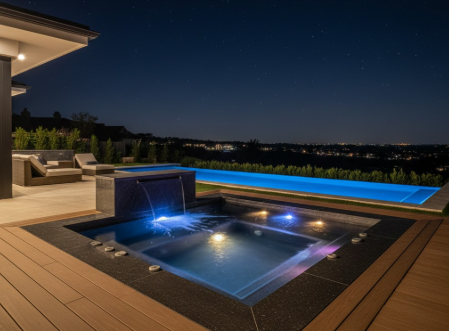
Premium spas from brands like Bullfrog, Marquis, and the upper tiers of Jacuzzi and Hot Spring command prices from ten thousand to over twenty-five thousand dollars. At these prices, you’re buying not just a hot tub but a comprehensive hydrotherapy system with advanced features, superior construction, and extensive warranty protection.
Advanced Hydrotherapy, Automation, and Design Aesthetics
Luxury spas distinguish themselves through hydrotherapy sophistication. Expect proprietary jet systems with patented designs, customizable massage zones, and precise pressure control. Some brands like Bullfrog offer interchangeable jet packs that let you swap different massage configurations into the same seat positions.
Automation features reach their apex in premium spas. WiFi connectivity allows remote monitoring and control through smartphone apps. Some models integrate with smart home systems. Advanced filtration scheduling, automatic chemical dosing, and predictive maintenance alerts reduce owner involvement while ensuring optimal water quality.
Build quality justifies much of the premium pricing. Shells are thicker, often approaching half-inch acrylic. Insulation systems are comprehensive and engineered rather than simply adequate. Cabinet materials resist weathering and require minimal maintenance. Frame construction uses materials impervious to moisture and pest damage.
Long-Term Durability and Resale Value
Premium spas routinely deliver fifteen to twenty-five years of service life when properly maintained. Warranties reflect this durability, with lifetime structural warranties and extended component coverage becoming common.
Resale value holds better for recognized premium brands. A well-maintained luxury spa can retain forty to sixty percent of its original value after a decade, while entry-level and mid-range models depreciate to near-zero. If you anticipate selling your home or upgrading to a different spa eventually, premium models offer better financial recovery.
Swim Spas vs. Hot Tubs: Knowing the Difference
Swim spas combine hot tub features with a swimming area in one unit. They range from twelve to twenty-one feet in length and provide current systems that allow stationary swimming or aquatic exercise.
Swim spas make sense for users wanting both exercise capability and hydrotherapy relaxation without installing separate pools and hot tubs. They’re particularly popular in regions where traditional pools are impractical due to climate or space constraints.
However, they’re substantial investments, typically starting around fifteen thousand dollars and reaching fifty thousand dollars or more for premium models. Installation requirements are more demanding due to their size and weight. Operating costs exceed standard hot tubs due to larger water volumes and current generation systems.
Consider a swim spa if aquatic exercise is a primary goal and you have the space, budget, and installation capability to support one. For pure hydrotherapy and relaxation, a traditional hot tub likely serves you better at lower cost.
Core Construction: Shell, Cabinet, and Framing
Construction quality determines how long your hot tub lasts and how well it performs over time. Understanding materials and build methods helps you distinguish genuinely superior construction from marketing hype.
Acrylic Shells vs. Rotomolded Plastic
The shell is your hot tub’s most visible and critical component. It contains the water, provides seating surfaces, and houses the jets. Material choice significantly impacts durability, appearance, and maintenance requirements.
Understanding Continuous Cast Acrylic and Fiberglass Backing
Quality hot tub shells use vacuum-formed acrylic sheets. The acrylic starts as a flat sheet that’s heated, then pulled into a mold by vacuum pressure. This process creates the spa’s shape while maintaining uniform thickness.
Continuous cast acrylic, sometimes called cell cast, offers superior color stability and surface durability compared to extruded acrylic. It resists UV fading better and maintains its gloss longer. Most reputable manufacturers use continuous cast material, though some economy brands cut costs with extruded alternatives.
After forming, the acrylic shell receives fiberglass backing for structural reinforcement. Multiple layers of fiberglass and resin bond to the acrylic, creating a laminate structure several times stronger than acrylic alone. This backing prevents flexing that could crack the acrylic and provides mounting points for jets and plumbing.
Better manufacturers apply fiberglass by hand with multiple layers, ensuring complete coverage and consistent thickness. Economy operations may use spray application or fewer layers, resulting in weaker shells more prone to problems.
The Importance of Shell Thickness and Blistering Resistance
Shell thickness affects durability and perceived quality. Premium shells measure three-eighths to half inch at the acrylic layer alone. Economy shells may be one-quarter inch or thinner. Thicker shells resist impact damage better and feel more substantial during use.
Blistering occurs when moisture penetrates between the acrylic and fiberglass layers, creating bubbles that expand and contract with temperature changes. Eventually, these blisters can crack and compromise shell integrity. Quality manufacturing with proper surface preparation and complete fiberglass coverage prevents blistering. Warranties that specifically cover blistering indicate manufacturer confidence in their process.
Frame Materials: Wood vs. Metal vs. Composite
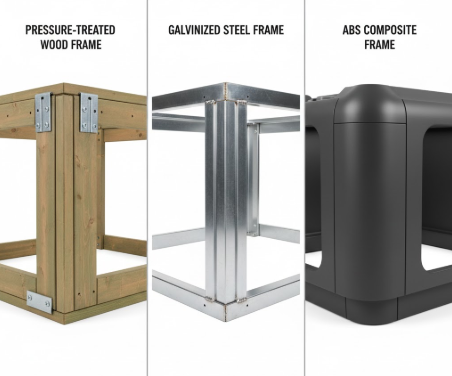
The frame provides structural support for the shell, holds components in place, and anchors the cabinet. Material choice affects durability, especially in humid hot tub environments.
The Risk of Rot in Treated Wood Frames
Many mid-range spas use pressure-treated pine or fir for framing. While treatment provides some protection, these materials remain vulnerable to moisture damage over time. In the warm, humid environment beneath a hot tub, even treated wood can develop rot within five to ten years.
Inspect wooden frames carefully during your evaluation. Look for any signs of moisture damage, fungal growth, or soft spots. Ask dealers about the treatment method and expected lifespan. Better wooden frames use naturally rot-resistant species like cedar or redwood, though these add cost.
Advantages of Galvanized Steel and ABS Composite Frames
Premium spas increasingly use galvanized steel or ABS plastic composite framing that eliminates moisture concerns entirely. These materials cannot rot, won’t harbor mold or mildew, and maintain structural integrity indefinitely.
Galvanized steel provides excellent strength-to-weight ratios and allows precise manufacturing tolerances. The zinc coating prevents corrosion even in constantly humid conditions. Look for fully welded rather than bolted construction, which eliminates fastener corrosion concerns.
ABS composite frames offer similar durability advantages with easier manufacturing. This engineered plastic material shrugs off moisture exposure and won’t support biological growth. Some manufacturers use hybrid designs with ABS structural panels and steel reinforcement at high-stress points.
Cabinetry and Skirting Options
Cabinet panels form your spa’s exterior appearance and protect internal components from weather and pests. Material selection affects both aesthetics and maintenance requirements.
Synthetic Wood Longevity Versus Natural Cedar Maintenance
Natural wood cabinets, typically cedar or redwood, offer beautiful aesthetics that complement outdoor living spaces. However, they require ongoing maintenance including annual sealing or staining to prevent graying, checking, and eventual deterioration. In wet climates or shaded installations, wood cabinets may develop mold or mildew requiring additional attention.
Synthetic cabinet materials, including composite wood alternatives and polymer panels, eliminate maintenance concerns while offering wood-like appearances. Quality synthetic panels resist fading, won’t rot or mold, and clean easily with mild detergent. They cost more initially but eliminate ongoing maintenance expenses and hassle.
Some premium brands offer cabinet customization with colors, textures, and accent lighting that enhance design integration with your outdoor space. Consider how the spa’s appearance coordinates with your home’s architecture and landscaping.
Base Pan and Pest Protection
The spa’s bottom represents a vulnerability that cheaper manufacturers often neglect. A proper base pan protects against moisture infiltration, pest intrusion, and ground-level contamination.
Why a Solid ABS Bottom Pan is Essential for US Climates
Quality spas include a complete ABS plastic bottom pan that fully encloses the underside. This pan prevents rodents, insects, and moisture from accessing internal components. It also contains any minor leaks, preventing immediate ground contamination and providing early leak detection.
Open-bottom designs, common in economy spas, leave components vulnerable. Mice and other rodents frequently nest in the warm, protected space beneath hot tubs, chewing through wiring and insulation. Ground moisture wicks upward, accelerating component deterioration. Leaks go unnoticed until they’ve caused significant damage.
Examine the base pan during your evaluation. Ensure it provides complete coverage without gaps or access points. In regions with significant pest pressure, this single feature can dramatically extend equipment lifespan and prevent frustrating service calls.
Insulation Systems and Energy Efficiency
Insulation quality directly impacts your operating costs and the spa’s ability to maintain temperature in challenging conditions. Understanding insulation approaches helps you evaluate efficiency claims and predict real-world performance.
The Importance of R-Value in Cold Climates

R-value measures thermal resistance, or how effectively insulation prevents heat transfer. Higher R-values indicate better insulation performance. In hot tubs, effective insulation keeps heat in the water rather than allowing it to escape into surrounding air.
Climate dramatically affects insulation requirements. A spa in Phoenix faces different challenges than one in Minneapolis. Northern US installations benefit significantly from superior insulation, while southern installations may find mid-grade insulation perfectly adequate.
Calculate potential savings based on your local climate and electricity costs. In regions with cold winters and high utility rates, the difference between basic and premium insulation can exceed three hundred dollars annually in operating costs. Over a ten to fifteen year ownership period, superior insulation may pay for itself multiple times.
Full Foam Insulation
Full foam insulation fills the entire cavity between the shell and cabinet with expanding polyurethane foam. This approach provides excellent thermal performance and structural reinforcement.
Benefits for Structural Support and Heat Retention
The foam adheres to the shell, plumbing, and frame, creating a monolithic structure that resists vibration and flexing. This adhesion reduces jet noise transmission and prevents plumbing movement that could cause leaks over time. The comprehensive coverage eliminates thermal gaps that would otherwise allow heat escape.
Full foam spas typically offer the best energy efficiency ratings and maintain temperature well even in extreme cold. The insulation’s R-value, combined with its complete coverage, minimizes heat loss through all surfaces.
Potential Drawbacks for Leak Detection and Repair
The same completeness that makes full foam effective also complicates repairs. When a leak develops, technicians must excavate through foam to reach affected plumbing. This process is time-consuming, expensive, and messy. After repair, the foam must be replaced, adding further cost.
Leak detection itself becomes more difficult with full foam. Water can travel along plumbing lines within the foam before emerging, making source identification challenging. Some modern manufacturers address this by creating service channels through the foam or using zoned foam application that allows targeted access.
Perimeter and Thermal Pane Insulation
Perimeter insulation represents an alternative philosophy that insulates the cabinet walls while leaving the equipment area more accessible.
Utilizing Waste Heat from Pumps to Warm the Water
This approach argues that pumps and heaters generate significant waste heat during operation. By containing this heat within the equipment area rather than insulating it away, the spa captures energy that would otherwise be lost. Fans may circulate warm air from the equipment area to enhance this effect.
Proponents claim this design approach can match or exceed full foam efficiency while dramatically simplifying service access. Critics counter that the heat recapture benefit is overstated and that perimeter systems inherently have more thermal gaps than full foam designs.
Real-world performance varies by specific implementation. Well-engineered perimeter systems from quality manufacturers perform admirably. Poorly executed versions using the approach primarily as a cost-reduction measure may underperform significantly.
Fiber/Blanket Insulation and Multi-Layer Approaches
Some manufacturers use fiberglass blankets or reflective foil barriers as insulation layers. These approaches cost less than foam but provide varying levels of effectiveness.
Multi-layer approaches combine different insulation types to capture benefits of each. A spa might use foam on the shell bottom where heat loss is greatest, blanket insulation on the walls, and reflective barriers on the cabinet interior. Thoughtfully designed multi-layer systems can perform well, but execution quality matters significantly.
Understanding the California Energy Commission (CEC) Standards
California Energy Commission standards establish minimum efficiency requirements for portable electric spas sold in California. These standards, expressed in standby watts, measure how much power a spa consumes to maintain temperature when not in active use.
CEC requirements have tightened progressively, pushing manufacturers toward better insulation and more efficient components. Current standards require spas to maintain temperature at a cost of approximately thirty to fifty dollars monthly in typical California climates.
Even if you’re not in California, CEC ratings provide useful comparison benchmarks. Spas meeting current CEC standards will perform efficiently regardless of where they’re installed. Look for CEC compliance documentation during your evaluation.
Estimating Monthly Electricity Costs by Region
Real-world operating costs depend on your climate, local utility rates, desired temperature settings, and spa usage patterns. However, general estimates provide useful budgeting guidance.
In moderate climates with average electricity rates, expect monthly costs between twenty and forty dollars for well-insulated spas used several times weekly. Northern climates with harsh winters may see costs climb to sixty to one hundred dollars during peak heating months. Southern installations with minimal heating needs may cost as little as fifteen to twenty-five dollars monthly.
Calculate your estimate by determining your local rate per kilowatt-hour, then applying it to the spa’s expected consumption. Manufacturers or dealers should provide standby wattage ratings that enable this calculation. Add an allowance for active use including jet pumps and heating recovery after soaking sessions.
The Mechanics: Pumps, Jets, and Heaters
The mechanical systems delivering hydrotherapy determine your spa’s performance, reliability, and operating costs. Understanding these components helps you evaluate competing models and anticipate maintenance needs.
Horsepower Myths vs. Water Flow Reality
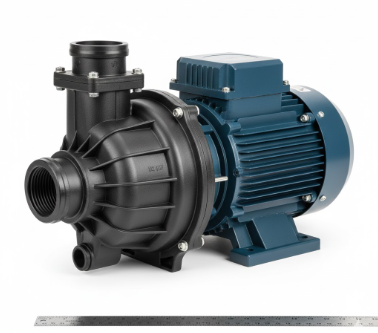
Pump horsepower ratings cause widespread confusion due to inconsistent measurement practices within the industry. Understanding what the numbers actually mean helps you compare systems meaningfully.
Continuous Duty Pumps vs. Brake Horsepower Marketing
Manufacturers may advertise “brake horsepower” (BHP) or “total horsepower” (THP) ratings that represent theoretical maximums never actually delivered during operation. A pump advertised at “5 HP” might deliver only 2.5 to 3 HP of continuous output.
Look for continuous duty or service factor ratings that indicate actual sustained performance. Better yet, focus on flow rates measured in gallons per minute rather than horsepower alone. A pump that moves more water through the jets delivers better massage regardless of its horsepower rating.
Multiple-speed pumps offer efficiency advantages. A pump might run at low speed for filtration and circulation while switching to high speed only during active hydrotherapy use. This approach reduces electrical consumption and pump wear during the many hours the spa sits idle.
Jet Count vs. Jet Placement and Variety
Marketing heavily emphasizes jet count, leading buyers to assume more jets automatically mean better hydrotherapy. Reality is considerably more nuanced.
Targeted Hydrotherapy Zones: Neck, Shoulders, and Calves
Effective hydrotherapy targets specific muscle groups with appropriate jet types and pressures. Random jet placement with uniform jet types delivers less therapeutic benefit than thoughtful designs with fewer but properly positioned jets.
Evaluate jet layouts by considering where you typically experience muscle tension. Most people benefit from concentrated attention to neck and shoulder areas, lower back, and calves. Jets should be positioned to hit these areas when you’re seated naturally, not requiring awkward positioning to reach the water flow.
Look at how jets are grouped and powered. Better designs dedicate specific pumps or pump zones to different seat positions, allowing independent adjustment. Economy designs may power all jets from a single pump, meaning you share pressure with other bathers and can’t customize your experience.
Rotational, Directional, and Pulsating Jet Types
Jet variety enhances therapeutic versatility. Different jet types provide different sensations suitable for different needs.
Rotational jets spin to create a kneading sensation effective for large muscle groups. Directional jets provide focused streams you can aim at specific areas. Pulsating jets create rhythmic pressure variations that some users find more relaxing than constant streams. Combination jets incorporate multiple functions in single housings.
Premium spas offer extensive jet variety with different types targeted to different body areas. The neck might receive small, focused jets while the back gets larger rotating jets and the feet receive air-infused bubbler jets. This variety creates more comprehensive hydrotherapy experiences.
Jet adjustability matters significantly. Individual jets should be adjustable from fully open to completely closed, allowing you to customize pressure distribution across your body. Some jets should offer directional adjustment to fine-tune targeting.
Heater Types and Performance
Heaters determine how quickly your spa reaches desired temperature and how effectively it maintains that temperature during use and cold weather.
Titanium vs. Incoloy Heating Elements
Heating elements must withstand constant contact with chemically treated hot water while delivering consistent performance. Element material affects durability and resistance to scale buildup and corrosion.
Titanium elements offer superior corrosion resistance and longer life, particularly in aggressive water conditions or with salt water systems. They cost more but typically outlast other materials significantly.
Incoloy (a nickel-iron-chromium alloy) provides excellent performance at lower cost than titanium. Most mid-range spas use Incoloy elements successfully for many years. Stainless steel elements appear in economy spas but may have shorter lifespans in challenging water conditions.
Heating Speed and 110V vs. 220V Considerations
Heater wattage determines heating speed. Standard heaters range from 1.5 to 6 kilowatts, with higher wattages heating faster but requiring more electrical capacity.
The 110V versus 220V distinction significantly impacts heating capability. Standard household 110V circuits limit maximum wattage to around 1.5 kW due to amperage constraints. This limitation means 110V spas heat slowly and may struggle to maintain temperature in cold weather or during extended use.
220V installations support heaters of 4 to 6 kW, providing dramatically faster heating and better temperature maintenance. The heater can run simultaneously with jet pumps, something most 110V systems cannot do. For year-round use in most US climates, 220V installation is strongly recommended.
Control Systems and User Interfaces
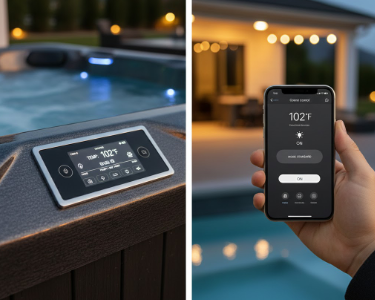
The control system serves as your spa’s brain, managing heating cycles, pump operation, filtration, and user interface functions. Quality and capability vary significantly across manufacturers.
Balboa, Gecko, and Proprietary Control Packs
Most hot tub manufacturers don’t build their own control systems. Instead, they purchase from specialized suppliers like Balboa Water Group, Gecko Alliance, or SpaNet. These companies provide proven, reliable electronics with established support networks.
Balboa controls appear in more hot tubs worldwide than any other brand. Their systems are well-documented, widely understood by service technicians, and supported by readily available replacement parts. Gecko systems offer similar advantages with some proprietary features.
Some premium manufacturers develop proprietary controls offering unique features or tighter integration with their systems. These may provide advantages but also create service considerations. Ensure proprietary control manufacturers have strong reputations and adequate dealer support networks before committing.
Understanding your spa’s control manufacturer helps with future service needs. The pumps, heaters, and control systems are the workhorses of any hot tub. Our detailed guide to Hot Tub Pumps explains what to look for and how to evaluate pump quality.
WiFi Connectivity and App-Based Remote Monitoring
Modern control systems increasingly offer WiFi connectivity enabling smartphone monitoring and control. These features allow you to check water temperature, adjust settings, and receive alerts from anywhere with internet access.
Practical benefits include pre-heating the spa from work so it’s ready when you arrive home, receiving filter or water care reminders, and getting alerts if temperatures fall unexpectedly indicating potential equipment issues. Some systems integrate with smart home platforms for voice control and automation.
Evaluate WiFi features carefully before paying premium prices for them. Some implementations are polished and reliable while others are frustrating and inconsistent. Read user reviews specifically mentioning app functionality.
Water Care and Filtration Systems
Water quality directly affects your health, comfort, and spa longevity. Understanding filtration and sanitation options helps you select systems matching your maintenance preferences and sensitivity considerations.
Traditional Filtration Cycles
Filtration removes physical debris and provides circulation that distributes heat and chemicals evenly. Effective filtration is foundational to water quality regardless of what sanitation method you choose.
Suction-Side vs. Pressure-Side Filtration
Suction-side filtration draws water through the filter before it reaches the pump. This approach protects pump components from debris but limits flow rates based on filter resistance. Most residential hot tubs use suction-side designs.
Pressure-side systems filter water after the pump, allowing higher flow rates but exposing pump components to unfiltered water. These systems appear more commonly in commercial installations where turnover rates take priority.
Circulation pumps running continuously at low speed provide consistent filtration without the energy cost of full-speed jet pump operation. Many spas include dedicated circulation pumps that run twenty-four hours daily, turning over the entire water volume multiple times. This continuous filtration maintains better water quality with less chemical intervention.
Micron Ratings and Filter Square Footage
Filter effectiveness depends on both the micron rating (how small a particle the filter catches) and the total filter surface area. Hot tub filters typically rate between twenty and fifty microns, with lower numbers indicating finer filtration.
Larger filter surface area extends cleaning intervals and improves filtration effectiveness. Look for total square footage ratings when comparing spas. Premium spas may offer one hundred square feet or more of filter area, while economy models might provide half that capacity.
Multiple smaller filters sometimes replace single large filters. Either approach can work well, but multiple filters allow staggered cleaning schedules that maintain continuous filtration capability.
Salt Water Hot Tub Systems
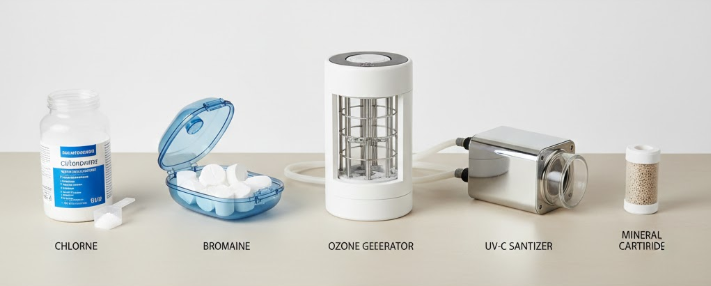
Salt water systems have gained popularity by offering reduced chlorine handling and gentler-feeling water. Understanding how they work and what they require helps you decide if this approach suits you.
Pros and Cons of Salt Generation
Salt water hot tubs use electrolytic cells to generate chlorine from dissolved salt, eliminating the need to add chlorine directly. The resulting sanitation is still chlorine-based, but the generation process and dissolved mineral content create water that feels softer and smells less chemically.
Benefits include reduced chemical handling, more consistent sanitation levels, and perceived improvements in skin feel and smell. Many users report the water feels silkier and causes less eye and skin irritation.
Drawbacks include higher initial equipment cost, cell replacement every two to five years at two hundred to four hundred dollars per cell, and potential corrosion concerns with some spa components. Salt systems also still require some supplemental chemistry management despite marketing claims of “chemical-free” operation.
Maintenance Requirements and Cell Replacement Costs
Salt cells require periodic cleaning to remove calcium buildup and eventually require complete replacement. Budget for cell replacement every three to five years depending on usage intensity. Some manufacturers void warranties if salt systems are added to spas not designed for them, so verify compatibility before adding aftermarket salt systems.
Water balance remains important with salt systems. Salt doesn’t eliminate the need for pH management, alkalinity adjustment, and periodic shocking. The chemistry is simpler for many users but not entirely maintenance-free.
Ozone Generators and UV-C Sanitation
Supplemental sanitation systems reduce chemical dependency while maintaining water quality. These technologies work alongside traditional chlorine or bromine rather than replacing them entirely.
How Ozonators Reduce Chemical Dependency
Ozone generators produce O3 molecules that oxidize contaminants on contact. This powerful oxidation destroys bacteria, viruses, and organic compounds without creating chemical residues. The ozone dissipates quickly, leaving no lasting residual, which is why chlorine or bromine are still needed for continuous sanitation.
With ozone supplementation, many users reduce their chlorine or bromine levels by fifty to seventy percent while maintaining equivalent sanitation. This reduction minimizes chemical odor, reduces skin irritation potential, and decreases ongoing chemical costs.
Ozone generators require replacement every three to five years as production efficiency degrades. Budget two hundred to three hundred dollars for replacement units plus installation if not DIY-capable.
Ultraviolet Light for Neutralizing Bacteria
UV-C sanitation passes water through a chamber containing ultraviolet light that destroys microorganisms’ DNA, preventing reproduction. Like ozone, UV provides point-of-contact sanitation without persistent residual, requiring traditional sanitizers for continuous protection.
UV systems are highly effective against chlorine-resistant organisms like cryptosporidium and giardia that occasionally contaminate recreational water. For users with health concerns or compromised immune systems, UV sanitation provides an additional safety layer.
UV bulbs require annual replacement, costing fifty to one hundred dollars. The systems consume modest electricity and add minimal operating cost.
Mineral Systems and Enzyme Treatments
Additional water treatment options can further reduce chemical dependency and improve water feel.
Reducing Skin Irritation and Chemical Odors
Mineral systems release silver and copper ions that provide supplemental sanitation with bacteriostatic and algaestatic properties. These systems, including popular brands like Frog and Nature2, allow significant reduction in primary sanitizer levels while maintaining water safety.
Enzyme treatments break down organic compounds like body oils, lotions, and cosmetics that cloud water and consume sanitizer. Regular enzyme use can reduce required sanitizer levels and extend water clarity between changes.
These supplemental treatments work best in combination rather than as standalone solutions. A comprehensive approach might include ozone or UV primary oxidation, mineral supplementation, enzyme treatment, and reduced-level traditional sanitizer as a persistent residual.
Electrical Requirements and Installation Logistics
Electrical installation represents a significant portion of total hot tub cost and involves important safety considerations. Understanding your options helps you budget accurately and ensure safe, code-compliant installation.
110V Plug-and-Play Spas
Plug-and-play spas operate on standard household circuits, enabling installation without electrician involvement. This convenience comes with significant performance limitations.
Easy Installation Limits and Heater Performance Trade-Offs
Standard 110V, 15-amp household circuits provide approximately 1,800 watts maximum. After accounting for pump operation, this leaves minimal capacity for heating. Most 110V spas cannot run heaters simultaneously with jet pumps, meaning the water cools during use and requires extended recovery time afterward.
Heating from cold takes dramatically longer with 110V systems. What a 220V spa accomplishes in four to eight hours may require twelve to twenty-four hours on 110V. In cold weather, 110V spas may struggle to reach or maintain desired temperatures.
Dedicated 15A vs. 20A Circuit Requirements
Plug-and-play spas require dedicated circuits not shared with other devices. A 15-amp circuit serving the spa alone prevents breaker trips and ensures consistent performance. Some larger plug-and-play models require 20-amp circuits, which may necessitate circuit addition even though no hardwiring is involved.
Consider 110V plug-and-play primarily for temporary installations, mild climates, or situations where electrical work is impossible. For permanent installations with year-round use expectations, the limitations typically prove frustrating.
220V Hardwired Systems
Most quality hot tubs require 220V/240V electrical service providing fifty to sixty amps. This configuration enables full heater operation with simultaneous jet pump use, delivering the complete hot tub experience.
The Role of the Licensed Electrician and Permitting
220V hot tub installation must be performed by a licensed electrician in virtually all US jurisdictions. This is not an appropriate DIY project regardless of your electrical experience. Code requirements, inspection processes, and insurance considerations all require professional installation.
Permitting requirements vary by location. Many jurisdictions require electrical permits for hot tub installation with subsequent inspection. Your electrician should handle permit acquisition and inspection scheduling as part of their service.
Sub-Panel Requirements and GFCI Disconnect Boxes
Hot tub circuits require a GFCI (ground-fault circuit interrupter) disconnect located within sight of the spa but at least five feet away. This disconnect allows the spa to be powered down quickly during emergencies and provides ground-fault protection preventing electrocution hazards.
The GFCI disconnect may be a standalone unit or integrated into a sub-panel that also provides the circuit breaker. Installation typically requires mounting a weatherproof enclosure on a post or wall near the spa location.
Trenching and Conduit Considerations
Running power from your electrical panel to the spa location typically requires underground conduit. Local codes specify burial depth, typically eighteen to twenty-four inches, and conduit requirements. This trenching adds cost and may complicate landscaping.
Budget for electrical installation ranging from six hundred to two thousand dollars depending on distance from the panel, trenching difficulty, and local labor rates. Get quotes from multiple licensed electricians before finalizing your spa purchase so you understand total project cost.
Delivery Day Expectations
Understanding delivery logistics prevents frustration and ensures smooth installation.
Curbside Delivery vs. Backyard Placement
Standard delivery typically means curbside only. The delivery truck drops the spa at your curb or driveway, and you’re responsible for moving it to the installation site. A seven hundred pound empty spa requires multiple strong helpers and appropriate equipment like furniture dollies or spa moving carts.
Many dealers offer white glove placement for additional fees, positioning the spa exactly where you want it, handling level adjustment, connecting to power, filling, and performing initial startup. This service costs three hundred to eight hundred dollars but eliminates significant effort and risk.
Crane Requirements for Difficult Access Points\
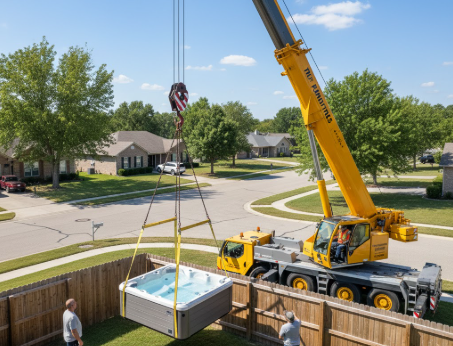
Enclosed backyards, rooftop installations, or homes with no viable ground-level path may require crane service. Professional crane companies routinely handle hot tub placement, lifting spas over houses, fences, or other obstacles.
Crane costs typically range from one thousand to twenty-five hundred dollars depending on lift complexity, equipment required, and regional rates. While expensive, crane service is sometimes the only option and prevents the injury risk associated with improvised lifting methods.
Vetting the Retailer and Understanding Warranties
The dealer you choose matters as much as the spa model you select. Post-purchase support, service capability, and warranty fulfillment all depend on dealer quality. Scrutinizing this relationship before purchase prevents future frustration.
Why the Dealer Matters More Than the Brand
A great spa from a poor dealer becomes a liability. A good spa from an excellent dealer becomes a reliable pleasure. Dealer quality affects your ownership experience more than most buyers realize.
Assessing Service Department Capabilities and Parts Inventory
Before purchasing, visit the dealer’s service department if possible. Ask about technician certifications, typical repair turnaround times, and parts inventory policies. A well-stocked parts inventory means common repairs happen quickly. Waiting weeks for parts transforms minor issues into extended downtime.
Ask how many service technicians the dealer employs and what their training backgrounds include. Balboa-certified technicians, manufacturer training, and years of experience all indicate capability. A single overworked technician serving a large customer base means long wait times for service appointments.
Inquire about service area limitations and travel charges. Some dealers provide service only within limited geographic areas or add substantial travel fees for distant customers. Understand these policies before purchasing.
Checking Reviews for Post-Sale Support and Repair Turnaround
Online reviews reveal dealer quality more accurately than showroom impressions. Search specifically for service-related reviews describing repair experiences, warranty claim handling, and communication quality. A few negative reviews among many positives are normal, but patterns of service complaints should give you pause.
Ask the dealer for references you can contact directly. Speaking with existing customers about their service experiences provides valuable insight that reviews alone may not capture.
Deconstructing the Warranty Fine Print
Warranties vary dramatically in actual protection provided. Surface-level comparison of warranty years misses crucial details that determine real-world coverage.
Pro-Rated vs. Non-Pro-Rated Coverage
Pro-rated warranties provide decreasing coverage over time. A five-year pro-rated pump warranty might cover one hundred percent in year one, eighty percent in year two, and so on. By year four, you’re paying most of the repair cost yourself.
Non-pro-rated warranties provide full coverage for the stated duration. A five-year non-pro-rated warranty means complete coverage through the final day of year five. Non-pro-rated coverage provides substantially more value.
Read warranty documents carefully. The headline numbers dealers emphasize may represent pro-rated periods while shorter non-pro-rated coverage appears in fine print.
Distinguishing Between Shell Structure, Surface, and Component Warranties
Hot tub warranties typically segment into multiple categories with different coverage periods. Shell structure warranties cover cracks or water loss through the shell. These are typically the longest, often five to ten years or even lifetime on premium spas.
Shell surface warranties cover the visible acrylic finish against blistering, fading, or delamination. These are typically shorter than structural coverage, often three to five years.
Component warranties cover pumps, heaters, controls, and jets. These are typically the shortest, often one to three years. Since components are most likely to need service, pay particular attention to this coverage.
Labor Limitations and Travel Charge Exclusions
Many warranties cover parts but not labor, or cover labor for only a portion of the warranty period. Others exclude travel charges for service calls entirely. These exclusions mean you may pay significant out-of-pocket costs even for covered repairs.
Read the complete warranty document, not just the summary. Ask dealers to clarify any ambiguous terms. Document their verbal explanations in writing if they differ from printed warranty language.
The Importance of the Wet Test
Never purchase a hot tub without sitting in it while it’s filled and operating. This wet test is the single most important step in the buying process.
Why You Must Sit in a Tub With Water Before Buying
Dry showroom displays tell you nothing about actual comfort. Seat depth, jet positioning, water buoyancy, and ergonomic fit can only be evaluated with water. A seat that looks perfect might position jets to hit your spine rather than muscles. A lounge that appears comfortable might not support your height properly.
Testing Jet Pressure, Noise Levels, and Seating Depth
During your wet test, activate all pumps at full speed. Evaluate jet pressure across different seats and positions. Note whether jets hit intended muscle groups or land in awkward locations. Check if jet adjustability allows you to customize the experience satisfactorily.
Listen for noise levels. Pump and jet noise varies significantly between models. What seems acceptable in a noisy showroom might prove irritating in your quiet backyard. Note any unusual vibrations or rattles that might indicate assembly issues.
Test every seat position, including loungers. Move around to evaluate flexibility for different users. If others will use the spa regularly, bring them for the wet test to ensure the model accommodates different body types.
Total Cost of Ownership Breakdown
The purchase price represents only the beginning of hot tub expenses. Understanding total ownership costs enables accurate budgeting and prevents unwelcome surprises.
Initial Purchase Price vs. Long-Term Costs
A spa’s purchase price often accounts for less than half of ten-year ownership costs. Operational expenses, maintenance supplies, repairs, and eventual replacement parts add substantially to your investment.
Chemicals and Consumables Budget
Water chemistry maintenance requires ongoing purchases of sanitizers, pH adjusters, test supplies, and specialty treatments. Budget forty to eighty dollars monthly for chemical consumables depending on water source quality, usage frequency, and your chosen sanitation approach.
Salt water and ozone-supplemented systems may reduce chemical costs by twenty to forty percent while adding periodic equipment replacement costs. Calculate long-term costs rather than immediate savings when evaluating these options.
Filter and Cover Replacement Schedules
Filters require cleaning every two to four weeks and replacement annually or when they no longer clean adequately. Quality replacement filters cost fifty to one hundred fifty dollars depending on your spa’s requirements.
Hot tub covers have finite lifespans. UV exposure, moisture absorption, and physical wear typically necessitate replacement every four to seven years. Quality covers cost three hundred to seven hundred dollars. Budget for this eventual expense and consider cover lifters that reduce wear from daily handling.
Projected Energy Bills Based on Local Utility Rates
Operating costs depend heavily on your local electricity rates and climate. As a baseline, expect twenty to fifty dollars monthly in moderate climates with average electricity prices. Cold climates may double this estimate during winter months.
You can estimate more precisely by multiplying your spa’s standby wattage by twenty-four hours, then by thirty days, then by your local rate per kilowatt-hour. Add an allowance for active use including jet pumps and post-use heating recovery.
Hidden Costs of Site Preparation and Electrical Work
Site preparation may include concrete pad installation at eight hundred to fifteen hundred dollars, deck reinforcement at five hundred to two thousand dollars, or landscaping modifications at varying costs.
Electrical installation typically runs six hundred to two thousand dollars for 220V service including GFCI disconnect, trenching, and code compliance. Permit fees may add one hundred to three hundred dollars depending on jurisdiction.
Include these costs when comparing total investment across different spa options. A less expensive spa requiring more site preparation might cost more overall than a pricier model fitting existing infrastructure.
Smart Shopping Tips and Negotiating
Informed shopping strategies help you maximize value while avoiding common pitfalls. Understanding dealer incentives and industry timing improves your negotiating position.
Best Times of Year to Buy a Hot Tub
Hot tub sales follow predictable seasonal patterns creating strategic purchasing opportunities.
Fall, particularly September through November, often provides excellent deals. Dealers clear summer inventory to make room for new model years. Weather remains pleasant for installation, and you have the spa ready for winter use.
January and February may offer clearance pricing on remaining prior-year inventory. However, cold weather complicates installation and delivery in northern climates.
Avoid peak summer months when demand peaks and dealer inventory runs tight. Spring can also be challenging as dealers anticipate strong summer sales and price accordingly.
Understanding Floor Models and Wet-Test Discounts
Floor models used for wet tests have depreciated value dealers may pass along as savings. These units have seen some use but typically remain in excellent condition. Negotiate ten to twenty percent discounts on floor models, ensuring the full warranty transfers.
Verify floor model history before purchasing. Ask how long it’s been on the floor, how often it’s been drained and refilled, and whether any repairs have been performed. Inspect carefully for any wear or damage.
Questions to Ask the Salesperson
Prepare specific questions that reveal dealer quality and commitment.
Who manufactures the shell, and where is assembly performed? Answers clarify actual origin regardless of brand marketing.
What’s your service department’s typical response time for repairs? Evasive answers suggest potential service problems.
Can I speak with a recent customer about their experience? Willingness to provide references indicates confidence in customer satisfaction.
What’s not covered by the warranty? This question reveals limitations salespeople might not volunteer.
What happens if your dealership closes? Understanding manufacturer backup support protects against dealer failure scenarios.
Negotiating Inclusions: Steps, Cover Lifters, and Chemical Starter Kits
Hot tub accessories offer negotiation opportunities. Steps, cover lifters, initial chemical supplies, and delivery/installation fees all present bargaining possibilities.
Steps ranging from one hundred to three hundred dollars should be included or heavily discounted with most purchases. Cover lifters at two hundred to four hundred dollars reduce cover wear and improve daily usability. Chemical starter kits valued at one hundred to two hundred dollars provide initial supplies with proper brand-specific formulations.
Ask for accessories as part of the negotiation rather than requesting price reductions. Dealers often have more flexibility on bundled accessories than on spa pricing.
Conclusion: Final Checklist Before You Sign
After absorbing this comprehensive guide, consolidate your knowledge into a final checklist ensuring you’ve addressed every critical factor.
Verify your site can accommodate the spa’s dimensions, weight, and utility requirements. Confirm delivery access and determine whether standard or white-glove placement is needed.
Understand the exact electrical requirements and obtain quotes from licensed electricians before finalizing your purchase. Include installation costs in your total budget calculation.
Complete a wet test in the actual model you’re considering, not just a similar unit. Evaluate comfort, jet positioning, and noise levels during active operation.
Read the complete warranty documentation. Note coverage periods, pro-rating terms, labor limitations, and travel charge policies. Document any verbal promises that differ from written terms.
Research the dealer thoroughly. Check service reviews, verify technician qualifications, and understand service area policies. A quality dealer relationship is essential for satisfactory long-term ownership.
Calculate total first-year costs including purchase price, site preparation, electrical installation, accessories, and initial operating supplies. Ensure the total aligns with your budget expectations.
Trust your instincts about both the spa and the dealer. If something feels wrong, walk away. Plenty of quality spas and dealers exist. Taking additional time to find the right combination beats rushing into a problematic purchase.
Frequently Asked Questions
What is the average lifespan of a hot tub?
Quality acrylic hot tubs typically last fifteen to twenty years with proper maintenance. Entry-level spas may last five to ten years, while premium models can exceed twenty-five years. Component replacements during this time are normal and expected.
How much does it cost to run a hot tub per month?
Monthly operating costs range from twenty to sixty dollars in moderate climates with average electricity rates. Cold climates or high utility rates may push costs to eighty dollars or more during winter months. Well-insulated spas cost less to operate.
Is a salt water hot tub better than chlorine?
Salt water systems offer softer-feeling water and reduced chemical handling but still produce chlorine through electrolysis. They cost more initially and require periodic cell replacement. Neither system is universally superior, and the choice depends on personal preferences and maintenance priorities.
Can I put a hot tub on a deck?
Yes, but most standard decks require structural reinforcement. Filled hot tubs with occupants can exceed one hundred pounds per square foot, far exceeding typical deck load ratings. Consult a structural engineer before placing any hot tub on an elevated deck.
Do I need a permit to install a hot tub?
Requirements vary by jurisdiction. Most areas require electrical permits for 220V installations. Some require general building permits for permanent hot tub installations. Check with your local building department before beginning installation.
What is the difference between 110V and 220V hot tubs?
110V plug-and-play spas connect to standard outlets but have limited heating capacity and cannot run heaters simultaneously with pumps. 220V spas require professional electrical installation but provide full heating power and better year-round performance.
How often should I change the hot tub water?
Drain and refill every three to four months under normal use. Heavy use, many bathers, or water quality problems may require more frequent changes. Regular testing helps determine optimal change intervals for your specific situation.
What are the health benefits of owning a hot tub?
Documented benefits include reduced muscle tension, improved sleep quality, temporary relief from arthritis symptoms, lower stress levels, and improved circulation. The Arthritis Foundation recommends warm water therapy for joint conditions. Always consult your physician regarding hot tub use with existing health conditions.
Can I use a hot tub in the winter?
Absolutely. Winter use is one of hot tub ownership’s greatest pleasures. Ensure your spa has adequate insulation and 220V electrical service for cold-weather performance. Keep the cover in good condition to maintain temperature efficiently.
What is the best hot tub brand for cold climates?
Brands known for superior insulation and cold-weather performance include Hot Spring, Sundance, Arctic Spas, and Bullfrog. Look for full-foam insulation, quality covers, and 220V heating systems. CEC compliance indicates good overall efficiency regardless of brand.


